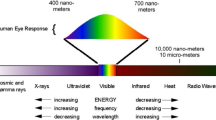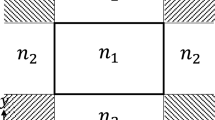Abstract
As a new kind of broadband microwave component, transmission characteristics of the dominant TE mode in inverted trapezoidal-ridge waveguide have been analyzed by finite element method. Variations of the cutoff wavelength, single-mode bandwidth, field patterns, characteristic impedance, attenuation constant and power-handling capacity with the varied ridge dimensions have been investigated in details. The longer cutoff wavelength, broader single mode bandwidth and lower characteristic impedance can be achieved for smaller ridge gap. While the lower attenuation and higher power-handling capacity can be realized for larger ridge gap. Numerical results in this paper provide an extension to the existing design data for ridge waveguide and are considered helpful in microwave and millimeter-wave applications.











Similar content being viewed by others
References
S.B. Cohn, Properties of ridge waveguide, Proc. IRE, 35 (1947), 783–788.
J.R. Pyle, Cutoff wavelength of the TE10 mode in ridged rectangular waveguide of any aspect ratio, IEEE Trans. Microwave Theory Tech 14 (1966), 175–183.
W. Sun and C.A. Balanis, Analysis and design of quadruple-ridged waveguides, IEEE Trans. Microwave Theory Tech 42 (1994), 2201–2207.
W. Sun and C. A. Balanis, MFIE analysis and design of ridged waveguides, IEEE Trans. Microwave Theory Tech., 41, (1993), 1965–1971.
Y. Rong and K.A. Zaki, Characteristics of generalized rectangular and circular ridge waveguides, IEEE Trans. Microwave Theory Tech 48 (2000), 258–265.
J. Helzajn, Ridge waveguides and passive microwave components. Institute of Electrical Engineers, London, 2000.
M. Lu and P.J. Leonard, Design of trapezoidal-ridge waveguide by finite element method, IEE Proc.-Microw.Antennas Propag 151 (2004), 205–211.
P.K. Saha and D. Guha, New broadband rectangular waveguide with L-shaped septa, IEEE Trans. Microwave Theory Tech., 40, (1992), 777–781.
P.K. Saha and D. Guha, Bandwidth and Dispersion Characteristics of a New Rectangular Waveguide with Two L-Shaped Septa. IEEE Trans. Microwave Theory Tech., 47, (1999), 87–92.
J.M. Jin, The finite element method in electromagnetics, 2nd ed., John Wiley and Sons, New York, (2002).
J. Helszajn and M. Mckay, Voltage-current definition of impedance of double ridge waveguide using the finite element method, IEE Proc.-Microw. Antennas Propag., 145, (1998), 39–44.
N. Marcuvitz, Waveguide Handbook. Stevenage, U.K.: Peregrinus, 1986.
Author information
Authors and Affiliations
Corresponding author
Rights and permissions
About this article
Cite this article
Chen, XQ., Ren, EE., Lu, M. et al. Analysis of the Transmission Characteristics of the Inverted Trapezoidal-Ridge Waveguide. J Infrared Milli Terahz Waves 31, 1005–1014 (2010). https://doi.org/10.1007/s10762-010-9676-2
Received:
Accepted:
Published:
Issue Date:
DOI: https://doi.org/10.1007/s10762-010-9676-2




